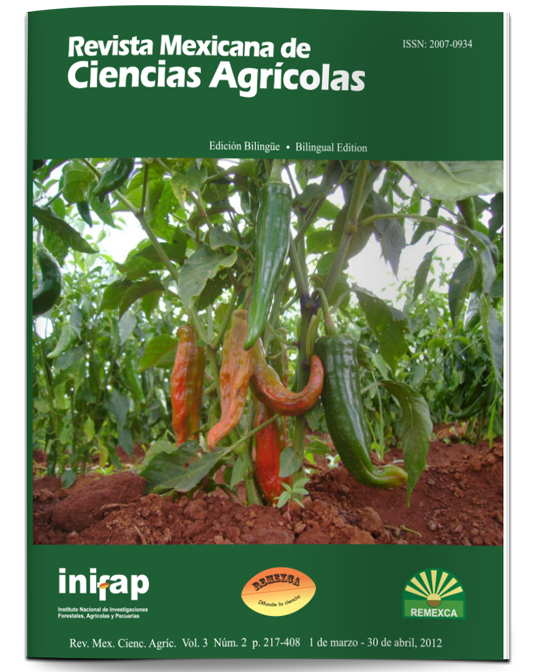Evaluation of synthetic insecticides on Metamasius spinolae (Coleoptera: Curculionidae) adults from Tlalnepantla, Morelos
DOI:
https://doi.org/10.29312/remexca.v3i2.1458Keywords:
Opuntia, chemical control, pests, weevilsAbstract
The cactus weevil, Metamasius spinolae (Gyllenhal), is one of the most important pests in prickly pear (Opuntia ficus-indica (L.) Miller) in Mexico and especially in Tlalnepantla, Morelos, the second most important region in the production of this crop, with about 2 500 ha. Both adults and larvae cause damage to this crop; larvae make galleries in mature pads and adults damage young pads of the cactus. Although there are no authorized pesticides for its control in Mexico, this fact does not stop farmers from using synthetic insecticides without knowing their effectiveness. For this reason, this study evaluated the effectiveness of eight pesticides in two chemical groups, organophosphates and pyrethroids, on adults of this insect. The laboratory and field tests conducted in 2007 showed that malathion caused a mortality similar to other more toxic products in the same group (Methyl Parathion and Methidathion). On the other hand, only a pyrethroid insecticide (Permethrin) provided a mortality rate close to 86%, in comparison to the remaining three (Cypermethrin, Deltamethrin and Fenvalerate) which caused a mortality of under 20% mortality. There was a differential response of the sex of the insect to insecticides, in which females were less susceptible than males to some products, such as Diazinon, Permethrin and Cypermethrin. This is the first formal report of the evaluation of synthetic insecticides in this insect and we discuss some issues related to management.
Downloads
Downloads
Published
How to Cite
Issue
Section
License
The authors who publish in Revista Mexicana de Ciencias Agrícolas accept the following conditions:
In accordance with copyright laws, Revista Mexicana de Ciencias Agrícolas recognizes and respects the authors’ moral right and ownership of property rights which will be transferred to the journal for dissemination in open access. Invariably, all the authors have to sign a letter of transfer of property rights and of originality of the article to Instituto Nacional de Investigaciones Forestales, Agrícolas y Pecuarias (INIFAP) [National Institute of Forestry, Agricultural and Livestock Research]. The author(s) must pay a fee for the reception of articles before proceeding to editorial review.
All the texts published by Revista Mexicana de Ciencias Agrícolas —with no exception— are distributed under a Creative Commons License Attribution-NonCommercial 4.0 International (CC BY-NC 4.0), which allows third parties to use the publication as long as the work’s authorship and its first publication in this journal are mentioned.
The author(s) can enter into independent and additional contractual agreements for the nonexclusive distribution of the version of the article published in Revista Mexicana de Ciencias Agrícolas (for example include it into an institutional repository or publish it in a book) as long as it is clearly and explicitly indicated that the work was published for the first time in Revista Mexicana de Ciencias Agrícolas.
For all the above, the authors shall send the Letter-transfer of Property Rights for the first publication duly filled in and signed by the author(s). This form must be sent as a PDF file to: revista_atm@yahoo.com.mx; cienciasagricola@inifap.gob.mx; remexca2017@gmail.
This work is licensed under a Creative Commons Attribution-Noncommercial 4.0 International license.



